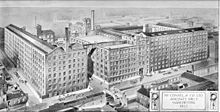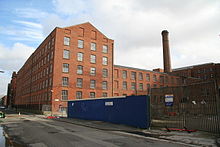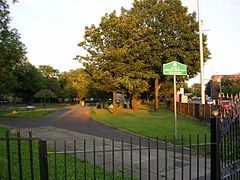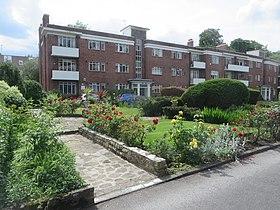Welcome to Visit Ancoats Places
The Walkfo guide to things to do & explore in Ancoats
![]() Visit Ancoats places using Walkfo for free guided tours of the best Ancoats places to visit. A unique way to experience Ancoats’s places, Walkfo allows you to explore Ancoats as you would a museum or art gallery with audio guides.
Visit Ancoats places using Walkfo for free guided tours of the best Ancoats places to visit. A unique way to experience Ancoats’s places, Walkfo allows you to explore Ancoats as you would a museum or art gallery with audio guides.
Visiting Ancoats Walkfo Preview
Historically in Lancashire, Ancoats became a cradle of the Industrial Revolution and has been called “the world’s first industrial suburb” The area suffered accelerating economic decline from the 1930s and depopulation in the years after the Second World War. The southern part of the area is branded as New Islington, by UK property developers Urban Splash. When you visit Ancoats, Walkfo brings Ancoats places to life as you travel by foot, bike, bus or car with a mobile phone & headphones.
Ancoats Places Overview: History, Culture & Facts about Ancoats
Visit Ancoats – Walkfo’s stats for the places to visit
With 443 audio plaques & Ancoats places for you to explore in the Ancoats area, Walkfo is the world’s largest heritage & history digital plaque provider. The AI continually learns & refines facts about the best Ancoats places to visit from travel & tourism authorities (like Wikipedia), converting history into an interactive audio experience.
Ancoats history
Medieval
The name Ancoats is likely to have derived from the Old English ana cots, meaning “lonely cottages” The settlement is first recorded as Elnecot in 1212. The village covered the area that roughly lies between the River Medlock and the River Irk.
Industrial Revolution

Survey work for the Rochdale Canal was carried out by James Brindley in 1765. The knowledge that its construction would make the transport of raw materials and finished goods more convenient gave industrialists the confidence to build their cotton mills. The first mills were built in Ancoats as early as 1790. In 1792 commissioners were established for the improvement of the township of Manchester, which included Ancoats. Towards the end of the 18th century steam power was first used to power the cotton mills. Some of the earliest mills of this period were Murray’s Mills, which were established next to the Rochdale Canal on Union Street (now Redhill Street) off Great Ancoats Street, by Adam and George Murray in 1798. Later, they became known as Ancoats Mills when they were operated by McConnel & Company Ltd. The streets of Ancoats were also laid out during the latter part of the 18th century, with little development taking place other than small houses and shops along Great Ancoats Street and Oldham Road (A62 road). From the opening of the Rochdale Canal in 1804 the development of mills continued on a much larger scale. Mills in Ancoats included Victoria Mills, Wellington Mill, Brunswick Mill, India Mills, Dolton Mills, Lonsdale Mills, Phoenix Mill, Lloydsfield Mill, Sedgewick Mill, Decker Mill (owned by the Murray brothers), New Mill, Beehive Mill, Little Mill, Paragon Mill, Royal Mill and Pin Mill. Ancoats grew rapidly to become an important industrial centre and as a result it also became a densely populated area. By 1815 Ancoats was the most populous district in Manchester. Streets of back-to-back houses and court dwellings were rapidly built. For the poorest members of the community, houses were split and cellars let separately. Public health was a concern; a survey motivated by the fear of a cholera outbreak showed that over half of homes in Ancoats had no private plumbing, and over half of streets were not cleaned. By the middle of the 19th century Ancoats was densely developed. In 1851 Ancoats’ total population was 53,737, larger than towns such as Bury and Blackburn. However, despite this large population, Ancoats lacked public buildings and spaces. There were no parks and the only public buildings were a few churches and a dispensary. As late as 1821 there had been no churches. Cotton was not the only industry in the locality, as foundries and engineering factories were required to produce the machinery needed by the mills. The largest of these were those operated by the brothers John Muir Hetherington and Thomas Ridley Hetherington, which were established in 1830. Eventually the company became known as John Hetherington and Sons Ltd and the principal factory was at Vulcan Works on Pollard Street. The company was also the proprietor of Curtis, Sons & Company, which was established in 1804 at the Phoenix Works, which were on both sides of Chapel Street (now Chapeltown Street). On one side of the street there was a brass and iron works and on the other side there was a machinery factory. Hetherington’s produced a huge range of machinery for the textile industry that included machinery for opening, preparing, spinning and doubling cotton, cotton waste, wool and worsted. Their speciality was a machine called a Combined Opener and Scutcher that was very effective in the cleaning of most types of cotton without damaging the staple or losing serviceable fibre. Possibly the least known, but vitally important, industry in Ancoats was the manufacture of flint glass. More than 25 glassworks have been identified in Manchester, all built during the 19th century, and many of these were in Ancoats. Thomas Percival and William Yates established one of these on Union Street (now Redhill Street) in 1844. The works was equipped with two furnaces (later three), an annealing house, workshops, a warehouse and offices. In 1852, Thomas Vickers joined the company and William Yates left in 1862. After this, the company became known as Percival Vickers British and Foreign Flint Glass Works. It made a large range of glassware that included tumblers, wine glasses, decanters, vases, celery vases, salts and cake stands. One of the buildings in Ancoats, the Flint Glass Works, still exists today and has been converted into serviced offices. At the top of Stony Brow (later Junction Street and now Jutland Street) there was the multi-storey drysalters factory of Thomas Hassall. It was said that this was the only drysalters in England and it supplied rock salt, moss litter and all kinds of other things. There were also chemical works (especially alum), floor-cloth works and finishing and calendering works that rolled cloth to smooth or glaze it.
Later Victorian period
Most of the Italians who arrived in Ancoats were from Liguria, in northwest Italy, and Frosinone and Gaeta, southeast of Rome. Over the next hundred years they created what became known as Ancoat Little Italy. Large numbers of Irish also settled in the city, with almost half of the men living there were born in Ireland.
Early 20th century
A.V. Roe (Avro) established his factory in Ancoats in 1910. Aircraft were made in Brownsfield Mill at the point where the Rochdale Canal passes below. In 1939, the Daily Express newspaper company opened new premises.
Post-war decline
Ancoats, like neighbouring Miles Platting and Collyhurst, became notorious for deprivation and crime. The substantial economic activity generated by such a concentration of mills was halted by the slump in the cotton industry in the 1930s. Thereafter, the prosperity of the mills declined steadily, and the only new industry to establish itself was newspaper printing. The mills, attracting decreasing rents, fell into disrepair.
Regeneration
In June 1989, Manchester City Council designated land bounded by Great Ancoats Street, Oldham Road, Kemp Street, Wadeford Close, Jersey Street and the Rochdale Canal into a conservation area. In 1990, the Eastside Regeneration was formed, the first organisation created to regenerate the area. Unfortunately, Manchester’s bids for the 1996 and 2000 Olympics caused speculative buying of property in the early 1990s.
Ancoats culture & places
The Hallé Orchestra is based at St Peter’s Church, Blossom Street Sankeys nightclub was in Beehive Mill on Radium Street closed officially in 2018. Hallé St Michael’s is a community space for the Hallé’s artistic and educational activities.
Ancoats landmarks

The following Listed buildings are in the Ancoats conservation area. Beehive Mill, Jersey Street and Brownsfield Mill are listed as Grade II*. Church of St. Peter, Blossom Street and Victoria Square are Grade II.
Why visit Ancoats with Walkfo Travel Guide App?
![]() You can visit Ancoats places with Walkfo Ancoats to hear history at Ancoats’s places whilst walking around using the free digital tour app. Walkfo Ancoats has 443 places to visit in our interactive Ancoats map, with amazing history, culture & travel facts you can explore the same way you would at a museum or art gallery with information audio headset. With Walkfo, you can travel by foot, bike or bus throughout Ancoats, being in the moment, without digital distraction or limits to a specific walking route. Our historic audio walks, National Trust interactive audio experiences, digital tour guides for English Heritage locations are available at Ancoats places, with a AI tour guide to help you get the best from a visit to Ancoats & the surrounding areas.
You can visit Ancoats places with Walkfo Ancoats to hear history at Ancoats’s places whilst walking around using the free digital tour app. Walkfo Ancoats has 443 places to visit in our interactive Ancoats map, with amazing history, culture & travel facts you can explore the same way you would at a museum or art gallery with information audio headset. With Walkfo, you can travel by foot, bike or bus throughout Ancoats, being in the moment, without digital distraction or limits to a specific walking route. Our historic audio walks, National Trust interactive audio experiences, digital tour guides for English Heritage locations are available at Ancoats places, with a AI tour guide to help you get the best from a visit to Ancoats & the surrounding areas.
“Curated content for millions of locations across the UK, with 443 audio facts unique to Ancoats places in an interactive Ancoats map you can explore.”
Walkfo: Visit Ancoats Places Map
443 tourist, history, culture & geography spots
Ancoats historic spots | Ancoats tourist destinations | Ancoats plaques | Ancoats geographic features |
| Walkfo Ancoats tourism map key: places to see & visit like National Trust sites, Blue Plaques, English Heritage locations & top tourist destinations in Ancoats | |||
Best Ancoats places to visit
Ancoats has places to explore by foot, bike or bus. Below are a selection of the varied Ancoats’s destinations you can visit with additional content available at the Walkfo Ancoats’s information audio spots:
 | Longsight Electric TMD Longsight Electric TMD is an AC electric railway locomotive traction maintenance depot situated in Longsight, Manchester, England . The depot code is LG (9A 1950 – 1973). It is one of the largest train depots in the United Kingdom and can hold 179 carriages at one time . |
 | Victoria Baths Victoria Baths opened to the public in 1906 and cost £59,144 to build . Manchester City Council closed the baths in 1993 and the building was left empty . A multimillion-pound restoration project began in 2007 and is on English Heritage’s Heritage at Risk Register . |
 | Edgar Wood Centre Edgar Wood Centre was designed by Edgar Wood in 1903 . Nikolaus Pevsner considered it “the only religious building in Lancashire that would be indispensable in a survey of twentieth century church design in all England” Grade I listed building is on Heritage at Risk Register . |
 | Victoria Park, Manchester Victoria Park is a suburban area of Manchester, England . Victoria Park lies approximately two miles south of Manchester city centre . It is located between Rusholme and Longsight . |
 | Dalton-Ellis Hall Dalton-Ellis Hall is a hall of residence complex at the University of Manchester . It is situated in the south of the city on Conyngham Road in Victoria Park, next to St Chrysostom’s Church . It has 279 male and female residents in catered accommodation . |
 | Ardwick Ardwick is a district of Manchester in North West England, one mile south east of the city centre . The population of the Ardwick Ward at the 2011 census was 19,250 . Historically in Lancashire, by the mid-nineteenth century Ardwick had grown from being a village into a wealthy suburb of Manchester . By the end of that century it had become heavily industrialised . |
 | O2 Apollo Manchester The O2 Apollo Manchester is a concert venue in Ardwick Green, Manchester . It is a Grade II listed building with a capacity of 3,500 (2,514 standing, 986 seats) |
 | Centre for Pharmacy Postgraduate Education The Centre for Pharmacy Postgraduate Education (CPPE) is part of the Manchester Pharmacy School, in the University of Manchester . In May 1991, CPPE was created as a direct response to the perceived lack of continuing professional development support given to community pharmacists . |
 | Appleby Lodge Appleby Lodge is a set of three-storey 1930s blocks of flats with eight entrance doors . The blocks are in a U-shape around a central garden in Rusholme, Manchester . |
 | Department of Earth and Environmental Sciences, University of Manchester The Department of Earth and Environmental Sciences at The University of Manchester is one of the oldest earth and environmental science departments in the UK . The Department takes roughly 100 new undergraduates and 140 postgraduates each year . |
Visit Ancoats plaques
![]() 181
181
plaques
here Ancoats has 181 physical plaques in tourist plaque schemes for you to explore via Walkfo Ancoats plaques audio map when visiting. Plaques like National Heritage’s “Blue Plaques” provide visual geo-markers to highlight points-of-interest at the places where they happened – and Walkfo’s AI has researched additional, deeper content when you visit Ancoats using the app. Experience the history of a location when Walkfo local tourist guide app triggers audio close to each Ancoats plaque. Explore Plaques & History has a complete list of Hartlepool’s plaques & Hartlepool history plaque map.